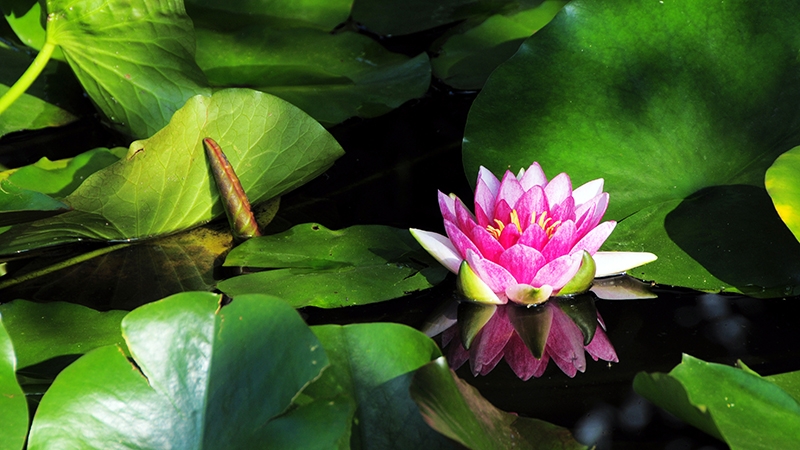Vitaleurythmie – basics
Vitaleurythmie encourages self-guidance, self-competency and development of one’s own resources. These “self-balancing” skills help us get to know ourselves again and again, and to feel comfortable in our own skin.
Being under too much stress and constantly pushing ourselves to the limit result in negative physical and emotional tension; over time, this tension can exhaust and demoralize us. But stressful situations are an inevitable part of everyday life. What’s important is to avoid “handing over the reins,” and to convert this activated energy into a positive force on several levels: physically, mentally, and emotionally. This allows us to transform chronic stress, muscle tension, stiffness, and irritability into energy, serenity, spiritual openness, flexibility, and dynamism.
The Vitaleurythmie concept has three primary pillars:
- We consider the basic nature of stress and its effects on life, health, and well-being.
- We look at how we experience stress individually, and develop navigational tools for recognizing various behaviors in stressful situations. We use mindfulness as an instrument to help us get in touch with ourselves and our environment in a non-judgmental way.
- We develop a strategy, clarify our motivations, and identify concrete objectives. We provide support and guidance in establishing short- and long-term behavioral strategies for coping with stress, focusing above all on sustainable approaches.
At the center of these three points are the movement exercises, which we use as an experiential way of understanding what we are focusing on, and what prospects we have for responding constructively.
Stress is our main topic, but we also use a similar approach to subjects like mindfulness, communication, teamwork, leadership, and personal mastery.
Christiane Hagemann and Michael Werner developed the Vitaleurythmie methods with the aim of stimulating and supporting physical, mental, and emotional vitality.

Vitaleurythmie – methods
The tools we use include coordinated sequences of movements, trainer-led exercises, small-group discussions, mindfulness, self-reflection and reflection on our experiences, creativity techniques, and short presentations. Depending on what we focus on thematically and in our exercises, Vitaleurythmie may have a variety of objectives and effects: it can release tension, activate and improve social perception skills, and clear up sleep disorders, as well as supporting team skills and improving group performance. You will experience deep physical and mental relaxation, and a marked sense of slowing down. You will develop greater awareness of group processes, making them easier to handle.
These Vitaleurythmie movement exercises utilize the principle of the powers of the four elements of nature: fire, water, air, and earth.
Vitaleurythmie takes eurythmy one step further: it incorporates elements of eurythmy, varies them, and builds upon them with a focus on stress, regeneration and revitalization.

Vitaleurythmie – goals
The goals of our work vary depending on what subject is in focus, and on whether you are coming to us individually or as part of a team, group, or organization. We would be happy to take your individual wishes into account.
Possible goals for individuals may include:
- getting in touch with yourself
- building your stress tolerance
- improving your own reactions to stress
- learning to relax
- developing individual mindfulness
- preventing exhaustion and burnout
- finding inner balance
- developing inner peace
- building vitality
- developing a sense of your own vitality
- finding lust for life
- improving your health through movement
- training your perception skills.
Possible goals for teams, groups, and organizations:
- improving communication
- developing mindfulness
- supporting teamwork
- facilitating interaction
- building your stress tolerance
- developing motivation
- increasing performance
- practicing conflict resolution skills.

Eurythmie – a hundred-year-old art of movement
The term “eurythmy” comes from the Greek, and translates literally as “beautiful rhythm.” “Beautiful” is not meant visually so much as in the sense of “harmonious” or “unity between inside and outside.”
Eurythmy is an art of movement that expresses the spirit that also inhabits language and music. It is practiced on stage, in the classroom, in the working world (occupational eurythmy) and in medicine (therapeutic/curative eurythmy).
Vitaleurythmie is derived from these: It uses the basic elements of eurythmy and adds concepts taken from stress research.
Eurythmy was originally developed by the scientist and philosopher Dr. Rudolf Steiner (1861-1925), who founded the spiritual science of Anthroposophy at the beginning of the 20th century.
Elements of language and music form the basis of eurythmy—the “material” it uses. The fact that individual consonants and vowels, the sounds’ dynamic energy fields, have an effect on the body and its functions is not mere hocus-pocus. Even Paracelsus said that every human being has an “inner doctor” possessing powers of revitalization and regeneration. Like eurythmy before it, Vitaleurythmie utilizes these life forces, which are constantly in flux and represent the entire spectrum of all sounds.
